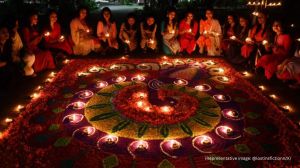How cricket went pop with one-day variety
London, May 10: An estimated two billion people across the globe will watch the cricket World Cup on television over the next six weeks.I...

London, May 10: An estimated two billion people across the globe will watch the cricket World Cup on television over the next six weeks.
If it hadn’t been for a particularly inclement spell of weather in the Melbourne area almost 20 years ago, they might have had to find something else to occupy their time.
The One-day game was born in the Victorian capital in January 1971, when three days of persistent rain washed out the third Test between England and Australia.
The rival captains, Bill Lawry and Ray Illingworth, went into a huddle with local officials — Don Bradman, as president of the Australian Cricket Board, was among them — and decided to write off the match in favour of a bit of fun — a 40-over-a-side game.
When 46,000 people turned up to watch, they realised they were onto something big.
Today, the One-dayer is part of the cricketing fabric, serving up frothy pop music for those struggling to digest the heavy Beethoven of Test matches.
For those not inclined to sit around for five days with every chance of watching a draw, the limited-over format offers a (relatively) quick fix.
It’s a sporting Russian Roulette, wrapped up in colourful pyjamas, sun-block and reflecting sunglasses. And, invariably, there is a result all but guaranteed after seven hours of play.
Many of its innovations — day-night games, musical accompaniments, and even a tearful duck hopping disconsolately across the bottom of television screens whenever a player is dismissed without scoring — were born out of Australian media mogul Kerry Packer’s attempts to create a rebel One-day cricket circuit in the late 1970s.
His intervention, which split the sport for a while, galvanised cricket — or at least its shorter, more dynamic format — into a rapid change of image.
Zones on the pitch were introduced to combat over-defensive fields. Whites were abandoned and players’ names and numbers began appearing on brightly-coloured kit.
Bowlers run-ups were cut down to speed up play. Bouncers and leg-side deliveries were outlawed. As the pendulum swung further towards batsmen, athletic fielders emerged as a counterbalance, becoming stars in their own right.
Whenever the game has threatened to lapse into stereotype — teams began batting cautiously for 20 overs, picking up the pace gradually over the next 20 and then thrashing away for the final 10 — new rules have been developed.
Sri Lanka’s 1996 World Cup win, for instance, was largely based on exploiting new fielding restrictions which encouraged attacking batting, or pinch-hitting, right from the opening stages.
Today, as the seventh World Cup approaches, One-day cricket has come of age.
In many parts of the world, and in the Indian subcontinent in particular — home of some 90 per cent of all cricket followers — it is the most popular form of the game.
The Sri Lankan squad boast 1,888 One-day caps between them, with Pakistan and India just behind. England, in contrast, have just over 600.
Limited-over tournaments come and go so fast in Asia that they are forgotten as soon as the last ball is bowled. The World Cup, however, is different.
Played only once ever four years, it retains its mystique as the game’s one `world championship’.
The winners of the World Cup final on June 20 may not be accepted as the best cricketing side in the world — the Test-loving traditionalists and the MCC’s tweed-jacketed, moustachioed members would never swallow that. But they will be seen as the most exciting and the most colourful.



- 01
- 02
- 03
- 04
- 05




























